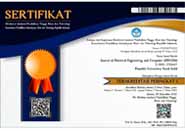Digital Transformation of Sugarcane Sales Administration at CV Al Ameen: Integration of Payment Automation and Visual Analytics for Distribution Optimization
Authors (s)
(1) Faiz Firdausi (Institut Teknologi dan Sains Mandala)
Indonesia
(2) Nely Supeni
 (Institut Teknologi dan Sains Mandala)
(Institut Teknologi dan Sains Mandala) Indonesia
(3) Ferry Wiranto
 (Institut Teknologi dan Sains Mandala)
(Institut Teknologi dan Sains Mandala) Indonesia
(4) Muhamat Abdul Rohim
 ()
() Indonesia
(5) * Riza Bahtiar Sulistyan

 (Institut Teknologi dan Sains Mandala)
(Institut Teknologi dan Sains Mandala) Indonesia
(*) Corresponding Author
AbstractThe sales administration of sugarcane at CV Al Ameen, Jember, is still managed manually, resulting in risks such as inaccurate records, delays in shipment monitoring, and irregular fund disbursement. The lack of a centralized system hinders real-time transaction recapitulation and creates opportunities for fraud, particularly duplicate payment claims. These inefficiencies not only threaten financial accuracy but also undermine the reliability of business reporting. To address these issues, this study proposes a digital administration system that automates transaction recording, verifies payment claims, and improves distribution monitoring accuracy. The system integrates a Telegram Bot for payment automation and interactive visual analytics to monitor both distribution and financial transactions in real time. It is initially implemented as an offline local application to ensure accessibility, with the potential for future adaptation to web- or cloud-based platforms. Key features include automatic transaction recap, Telegram-based notifications, and periodic reporting to business stakeholders without the need for manual record-keeping. The Telegram Bot employs unique delivery identifiers to validate claims, ensuring that each payment request is processed only once, thereby reducing the risk of fraudulent activity. System communication is achieved through the Telegram API and webhook mechanism, enabling automated updates on new transactions, shipment status, and fund disbursement. Furthermore, the bot supports user queries for transaction summaries and payment reminders. The system development follows the Agile Model, which allows iterative design and continuous refinement in line with business partner requirements. The findings demonstrate that the integration of automation and analytics significantly enhances accuracy, efficiency, and transparency in sugarcane sales administration. |
Keywords
Full Text: PDF
Refbacks
- There are currently no refbacks.
Copyright (c) 2025 Faiz Firdausi, Nely Supeni, Ferry Wiranto, Muhamat Abdul Rohim, Riza Bahtiar Sulistyan









